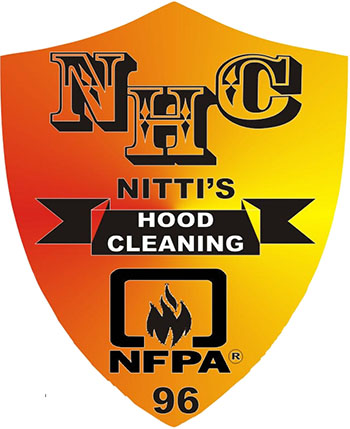NFPA-96 Cleaning Guidelines
Commercial cooking equipment
2.6.1.12(1) Commercial cooking equipment shall be provided with exhaust and fire protection systems in accordance with NFPA96, “Ventilation Control and Fire Protection of Commercial Cooking Operations”.
(2) Despite Sentence (1), existing exhaust or fire protection systems may be approved.
2.6.1.13. Commercial cooking equipment exhaust and fire protection systems shall be maintained in conformance with NFPA96 “Ventilation Control and Fire Protection of Commercial Cooking Operations”.
Excerpts
1-3 General Requirements
1-3.1 Cooking Equipment used in processes producing smoke or grease-laden vapours shall be equipped with an exhaust system that complies with all the equipment and performance requirements of this standard (NFPA96), and all such equipment and performance shall be maintained per this standard during all periods of operation of the cooking equipment. Specifically, the following equipment shall be kept in good working condition:
(a) Cooking Equipment
(b) Hoods
(c) Ducts (if applicable)
(d) Fans
(e) Fire Suppression Systems
(f) Special effluent or energy control equipment
All airflow shall be maintained. Maintenance and repairs shall be performed at intervals necessary to maintain these conditions.
1-3.1.1 Cooking equipment used in fixed, mobile, or temporary concessions, such as trucks, buses, trailers, pavilions, tents, or any form of roofed enclosure, shall comply with this standard unless all or part of the installation is exempted by the authority having jurisdiction (i.e. fire dept.)
1-3.3 A drawing (s) of the exhaust system installation along with a copy of operating instructions for subassemblies and components used in the exhaust system, including electrical schematics, shall be available on the premises.
8-3 Cleaning.
8-3.1 Hoods, grease removal devices, fans, ducts, and other appurtenances shall be cleaned to bare metal at frequent intervals prior to surfaces becoming heavily contaminated with grease or oily sludge. After the exhaust system is cleaned to bare metal, it shall not be coated with powder or any other substance. The entire exhaust system shall be inspected by a properly trained, qualified and certified company or person(s) acceptable to the authority having jurisdiction in accordance with Table 8-3.1.
Table 8-3.1 Exhaust System Inspection Schedule
|
Type or Volume of Cooking |
Frequency |
|
Systems serving solid fuel cooking operations |
Monthly |
|
Systems serving high-volume cooking operations such as 24-hour cooking, charbroiling or wok cooking |
Quarterly |
|
Systems serving moderate-volume cooking operations |
Semi-annually |
|
Systems serving low-volume cooking operations, such as churches, day camps, seasonal businesses, or senior centres |
Annually |
A-8-3.1 Cleaning to bare metal does not mean removing the paint from a painted surface of an exhaust system.
8-3.1.1 Upon inspection, if found to be contaminated with deposits from grease-laden vapours, the entire exhaust system shall be cleaned by a properly trained, qualified, and certified company or person(s) acceptable to the authority having jurisdiction in accordance with Section 8-3.
8-3.1.2 When a vent cleaning service is used, a certificate showing date of inspection or cleaning shall be maintained on the premises. After cleaning is completed, the vent cleaning contractor shall place or display within the kitchen area a label indicating the date cleaned and the name of the servicing company. It shall also indicate areas not cleaned.
8-3.2 Flammable solvents or other flammable cleaning aids shall not be used.
8-3.3 At the start of the cleaning process, electrical switches that could be activated accidentally shall be locked out.
8-3.4 Components of the fire suppression system shall not be rendered inoperable during the cleaning process.
Exception: Servicing by properly trained and qualified persons in accordance with Section 7.2
8-3.5 Care shall be taken not to apply cleaning chemicals on fusible links or other detection devices of the automatic extinguishing system.
8-3.6 When cleaning procedures are completed, all electrical switches and system components shall be returned to an operable state. All access panels (doors) and cover plates shall be replaced. Dampers and diffusers shall be positioned for the proper airflow.
